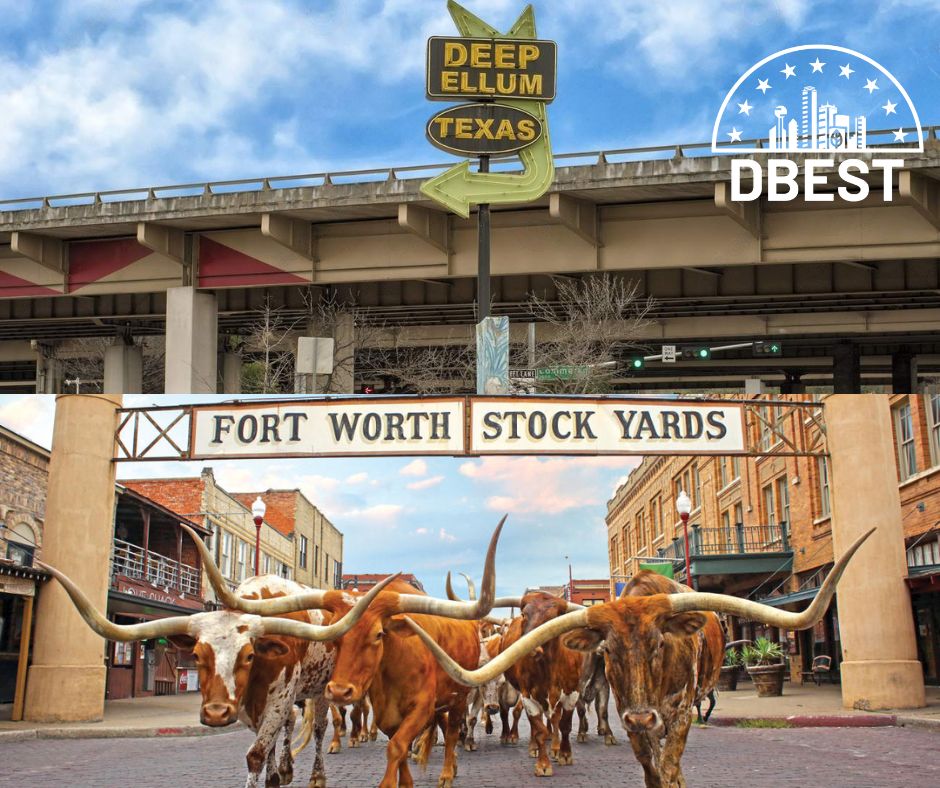Categories > Guides and Tips

Dallas vs Fort Worth: Which city is better to live in?
- The Cost of Living in Dallas vs. Fort Worth
- Crime Rate in Dallas vs. Fort Worth
- Education in Dallas vs Fort Worth
- Nightlife in Dallas vs. Fort Worth
- Population of Dallas vs. Fort Worth
- Is Dallas larger than Fort Worth?
- Living in Dallas: Pros
- Living in Fort Worth: Pros
- Living in Dallas: Cons
- Living in Fort Worth: Cons
Dallas and Fort Worth make up most of the DFW Metroplex, which is why they’re often associated with one another. They’re both very large cities though, so if we were to pick, which one’s better?
Dallas is the overall better city to live in. It’s got a bigger land area, education, and nightlife.
However, Fort Worth is cheaper to live in, less dense, and has less crime.
Dallas is better suited for those comfortable with city life, while Fort Worth is more for rural-loving residents.
A general overview won’t do any of these great cities justice, so let’s get into the specifics! But first, here are more details about how the two cities compare.
| Cost of Living | Dallas Average Cost | Fort Worth Average Cost |
| Housing | $1,971/month (Rent) $394,399 (Homeownership) $280,000 (Apartment Ownership) | $1,697/month (Rent) $325,626(Homeownership) $190,000 (Apartment Ownership) |
| Utilities | $182.56/month | $212.50/month |
| Transportation | $3 (Taxi) $2.75 (One-way Ticket for Train and Bus) $96 (Monthly Pass) | $3 (Taxi) $2.50 (One-way Ticket for Train and Bus) $95 (Monthly Pass) |
| Food | $75 (Mid-range Restaurant) $126.9/week (Groceries) | $48 (Mid-range Restaurant) $131.09/week (Groceries) |
| Healthcare | $6,374/year | $5,789/year |
| Education | $11,278/year (Private Preschool) $13,361/year (Private Elementary) $17,962/year (Private High School) $61,980/year (Southern Methodist University) | $8,029/year (Private Preschool) $11,028/year (Private Elementary) $12,582/year (Private High School) $57,130/year (Texas Christian University) |
| Taxes | 8.25% (Sales Tax) 2.22% (Property Tax) | 8.25% (Sales Tax) 2.26% (Property Tax) |
| Crime | Dallas Crime Index | Fort Worth Crime Index |
| Murder/Homicide | 0.18 | 0.12 |
| Rape | 0.44 | 0.49 |
| Robbery | 2.53 | 0.94 |
| Assault | 5.69 | 3.92 |
| Burglary | 7.62 | 3.71 |
| Larceny | 20.89 | 20.15 |
| Motor Vehicle Theft | 8.00 | 3.82 |
| Education | Dallas Top Schools | Fort Worth Top Schools |
| Preschool | 8 | 1 |
| Elementary | 2 | 0 |
| High School | 2 | 2 |
| Undergraduate | 9 | 3 |
| Nightlife | Dallas Establishments | Fort Worth Establishments |
| Number of Clubs | 133 | 54 |
| Atmosphere | Wild and loose | Laid-back |
| Population | Dallas Population | Fort Worth Population |
| Number | 1.3 million | 909,000 |
| Density | 3,934 people per sq. mi | 2,813 people per sq. mi |
| Growth Rate | 0.8% | 1.86% |
| Land Area | Dallas Land Area | Fort Worth Land Area |
| 343.5 sq. mi | 298.9 sq. mi |
The Cost of Living in Dallas vs. Fort Worth

Dallas has a higher cost of living than Fort Worth. All in all, Dallas residents pay an average of $3,288 a month while Fort Worth’s pay $3,011.
Housing, transportation, restaurant meals, and healthcare are more expensive in Dallas, but utilities and groceries are more expensive in Fort Worth.
Here’s a better view of how the two cities’ costs of living compare.
| Living Factor | Dallas Average Cost | Fort Worth Average Cost |
| Housing | $1,971/month (Rent) $394,399 (Homeownership) $280,000 (Apartment Ownership) | $1,697/month (Rent) $325,626(Homeownership) $190,000 (Apartment Ownership) |
| Utilities | $182.56/month | $212.50/month |
| Transportation | $3 (Taxi) $2.75 (One-way Ticket for Train and Bus) $96 (Monthly Pass) | $3 (Taxi) $2.50 (One-way Ticket for Train and Bus) $95 (Monthly Pass) |
| Food | $75 (Mid-range Restaurant) $126.9/week (Groceries) | $48 (Mid-range Restaurant) $131.09/week (Groceries) |
| Healthcare | $6,374/year | $5,789/year |
| Education | $11,278/year (Private Preschool) $13,361/year (Private Elementary) $17,962/year (Private High School) $61,980/year (Southern Methodist University) | $8,029/year (Private Preschool) $11,028/year (Private Elementary) $12,582/year (Private High School) $57,130/year (Texas Christian University) |
| Taxes | 8.25% (Sales Tax) 2.22% (Property Tax) | 8.25% (Sales Tax) 2.26% (Property Tax) |
Crime Rate in Dallas vs. Fort Worth

Fort Worth has a lower crime rate than Dallas. It has a total crime index of 33.16 crimes per 1,000 citizens while Dallas is at 45.35.
However, both cities’ crime rates are well above the state and national indices, which are 27.12 and 23 respectively.
Most of Fort Worth’s crimes are property crimes. It experiences an average of 27.86 crimes per 1,000 residents or a total of 25,440 reports per year.
Meanwhile, the city experiences an average of 5.47 violent crimes per 1,000 residents, or a total of 5,030 reports per year.
Similarly in Dallas, property crimes form the majority of its reports. It experiences an average of 36.51 per 1,000 residents or a total of 47,626 reports a year.
Dallas’ violent crimes also breach the 10,000 mark, averaging an 8.84 violent crime rate or a total of 11,534 reports a year.
To give you a better look, here are the individual crime statistics for both Dallas and Fort Worth from the Texas Department of Public Safety.
| Type of Crime | Dallas Crime Index (2021) | Fort Worth Crime Index (2021) |
| Murder/Homicide | 0.18 | 0.12 |
| Rape | 0.44 | 0.49 |
| Robbery | 2.53 | 0.94 |
| Assault | 5.69 | 3.92 |
| Burglary | 7.62 | 3.71 |
| Larceny | 20.89 | 20.15 |
| Motor Vehicle Theft | 8.00 | 3.82 |
Education in Dallas vs Fort Worth

Dallas’ schools outperform Fort Worth’s from preschool up to college. There are also more schools to choose from, but the caveat is that Dallas’ tuition is generally much more expensive.
Dallas tuition averages $14,200 per year from preschool to high school, while Fort Worth’s is at $10,546.
For preschools, The Private School Review ranks eight Dallas schools among the best in Texas while Fort Worth has just one. The average tuition for Dallas preschools is $11,278 though, while Fort Worth’s is just $8,029.
When it comes to elementary schools, Dallas has two ranked by USNews among the best elementary schools in Texas, while Fort Worth has none. The average tuition for Dallas elementary schools is $13,361 while Fort Worth’s is $11,028.
For high schools, Dallas and Fort Worth have two high schools each in Texas’ top 20 high schools by the Private School Review. Dallas’ average high school tuition is $17,962 while Fort Worth’s is $12,582.
Moving on to the university level, Dallas schools outperform and outnumber Fort Worth. Dallas has a total of nine universities to choose from while Fort Worth only has three.
Dallas’ top university is Southern Methodist University (SMU) while Fort Worth’s is Texas Christian University (TCU), according to UniversityGuru.
SMU ranks 94th on the Times Higher Education’s 2022 US College Rankings while TCU ranks 154th.
For a better overview of how the two cities’ education compares, check out this table below.
| Level of Education | Number of Top Schools in Dallas | Number of Top Schools in Fort Worth | Average Tuition |
| Preschool | 8 | 1 | Dallas: $11,278 Fort Worth: $8,029 |
| Elementary | 2 | 0 | Dallas: $13,361 Fort Worth: $11,028 |
| High School | 2 | 2 | Dallas: $17,962 Fort Worth: $12,582 |
| Undergraduate | 9 | 3 | Dallas (SMU): $61,980 Fort Worth (TCU): $57,130 |
Nightlife in Dallas vs. Fort Worth

Dallas has more clubs and bigger crowds than Fort Worth, and a large reason for this is how dense the cities in it are.
Dallas is more crowded than Fort Worth, meaning there are more bars, clubs, and bigger crowds. Dallas has a total of 133 clubs, while Fort Worth just has 54.
Fort Worth’s nightlife attracts a more laid-back crowd because there aren’t that many nightclubs to choose from.
In addition to the lack of choices, these clubs are all spread out so there’s no centralized party area in the city. If you plan to go bar or club-hopping, Dallas is much better.
Dallas’ nightlife is known for its high-end venues and exclusive clubs, particularly in the Downtown and Deep Ellum neighborhoods. You’ll find streets lined up with bars and clubs.
As a bonus, there are plenty of live music venues in the Big D — 200, to be exact. These venues often feature indie R&B artists but also hold open-mic nights.
On the other hand, Fort Worth gives more “cowboy” vibes, especially in the Stockyards District. This district is filled with saloons, rodeos, and Billy Bob’s — the world’s largest honky-tonk.
Outside of the Stockyards though, you won’t find as many clubs as you would in Dallas.
Population of Dallas vs. Fort Worth

Dallas has a bigger population than Fort Worth, but its growth rate is lagging behind by 1.06%.
According to the United States Census Bureau, the population of Dallas was approximately 1.3 million in 2019, while the population of Fort Worth was approximately 909,000 in the same year.
In addition, Dallas is the ninth most populous city in the United States, while Fort Worth is the 13th. Dallas is also denser than Fort Worth, with 3,934 people per square mile while Fort Worth has 2,813.
While Dallas has a bigger population, Fort Worth has a higher growth rate. Dallas’ growth rate in 2022 was just 0.8%, while Fort Worth’s was 1.86%.
From 2020 to 2022, Dallas’ population has grown at a rate of -0.19% while Fort Worth’s grew at 5.8%.
Here’s an overview of how Dallas and Fort Worth’s populations compare.
| Population | Dallas Population | Fort Worth Population |
| Number | 1.3 million | 909,000 |
| Density | 3,934 people per sq. mi | 2,813 people per sq. mi |
| Growth Rate (2022) | 0.8% | 1.86% |
Is Dallas larger than Fort Worth?

Dallas is larger than Fort Worth. According to the United States Census Bureau, the land area of Dallas is approximately 343.5 square miles, while the land area of Fort Worth is approximately 298.9 square miles.
Living in Dallas: Pros

Living in Dallas has its pros, specifically its great economy, developed neighborhoods, and abundance of healthcare facilities.
Dallas is known for having a booming economy. It is home to 22 Fortune 500 and 43 Fortune 1000 companies such as Texas Instruments, AT&T, Goldman Sachs, and Microsoft.
The abundance of big-name companies has led to a strong job market, meaning there are jobs for everyone. Dallas has an unemployment rate of 3.5%, which is among the lowest in the country.
The median household income in Dallas is also higher than the national average, making it a great place to live and work. Dallas’ median income is $54,747 per year, while the national average is $54,132 a year.
Dallas also has a variety of developed neighborhoods, with each being self-sufficient. These neighborhoods are clusters of homes, businesses, restaurants, public spaces and buildings, hospitals, and schools.
The city also has a strong cultural presence, with museums, galleries, and other attractions to explore. It’s also ranked 4th among the most diverse cities in the country, making this an excellent city for all demographics.
Finally, Dallas is known for its abundance of hospitals. This is great news for those looking for quality health care, as Dallas has a total of 44 hospitals scattered throughout the city.
Living in Fort Worth: Pros

Living in Fort Worth is perfect for anyone who wants to experience the culture, entertainment, and attractions of a major metropolitan area.
The city is home to several major employers and educational institutions, making it a great choice for anyone looking for a place to live and work.
It’s an affordable city. Compared to other major metros, Fort Worth offers very affordable housing and cost of living. This means you can have a comfortable lifestyle without breaking the bank.
It’s a great place to raise a family too. The city has tons of parks and recreation areas as well as a low crime rate.
As a bonus, Fort Worth Independent School District schools are ranked among the best schools in Texas. However, not all schools are ranked so highly and there are plenty that performs below average.
Traffic isn’t so bad either, at least compared to Dallas. Roads in Fort Worth are less congested than in its neighboring city, but public transportation isn’t as good.
Living in Dallas: Cons

The cons of living in Dallas are that residents have to deal with congested roads, high pollution, and a high crime rate.
Being a highly urbanized city, Dallas is set up as the 16th most polluted city in the US.
It also has a high crime rate of 45.35 reports for every 1,000 residents.
Dallas is notorious for its traffic and long commute times. The average commute time in Dallas is 28.4 minutes, which is slightly higher than the national average of 25 minutes.
Dallas also experiences at least 96 vehicular accidents a day, which can greatly extend your travel time.
The city is pretty dangerous to be in too. As of 2022, Dallas has a total crime index that is nearly double the national average.
Dallas’ crime index is 45.35, while the national average is 23. If it’s any consolation, most of these are non-violent crimes.
Living in Fort Worth: Cons

The cons of living in Fort Worth are its school system, public transportation, and the fact that it’s still an urbanizing city.
Fort Worth is still developing itself, meaning there are construction sites on every corner. These sometimes cause road blockages and also ruin the beauty of the city.
The Fort Worth Independent School District’s schools often face budgeting and overcrowding problems.
The Texas Education Agency gave it a C for 2022, and it’s been C-ranked for several years — the TEA’s lowest rank for listed schools.
TEA rankings are based on student progress, using metrics such as STAAR performance, graduation rates, and English language proficiency.
In addition to Fort Worth’s lackluster schooling, public transportation also lacks in some areas. Bus and rail routes don’t cover all of Fort Worth, making it hard to get around without a car.
If you do decide to travel by car or Uber, there are construction sites everywhere, with many causing road blockages. Plus, these construction sites ruin the aesthetic of the city and make it look like a sad concrete jungle.





